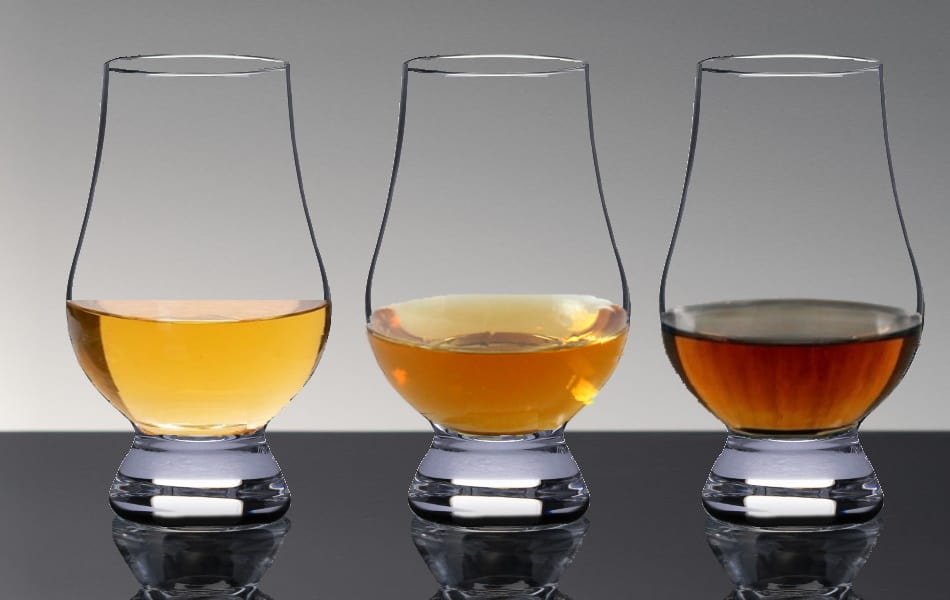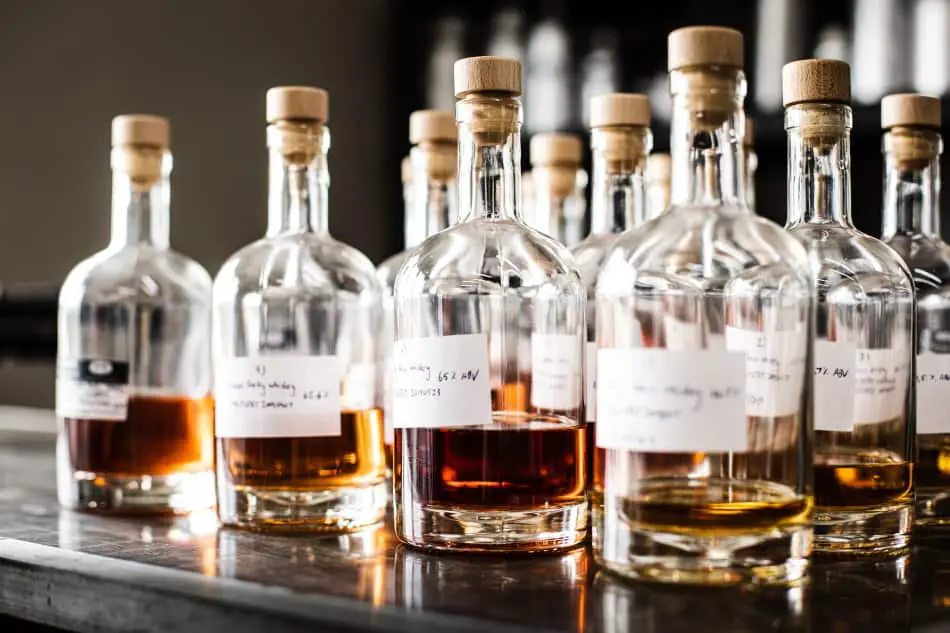I’ve never known exactly how to describe the color of whiskey and it doesn’t do justice both to the deliciousness of the drink and the beauty of its color to call it a particular shade of brown. Fortunately, some brands describe the color of their whiskeys, so I gathered the color descriptions of over 200 whiskeys and used that to find out what all the colors of whiskey are and how to describe them.
The most common colors that brands use to describe their whiskeys are a type of gold or amber. Other common colors used are amber gold, mahogany, honey, russet, copper and straw. Of course, whiskeys were described as a type or shade of one of these colors, most commonly light, bright, warm, medium or deep.
In the rest of this article, I’ll go into a bit more detail about what I found as well as the difference between whiskeys with a natural color and whiskeys that have caramel coloring added to it.
Throughout the article I’ve included examples that I found from the descriptions I collected, so if you happen to be drinking that particular whiskey, you’ll know exactly what color it is and how to describe it.

The Colors of Whiskey
While most brands did not use one word to describe the color of their whiskeys, it was interesting that most descriptions were a form of one of these eight colors.
- Gold
- Amber
- Amber gold
- Mahogany
- Honey
- Russet
- Copper
- Straw
However, it was not the case that each color was used about the same number of times. Not even close. Gold was used 41% of the time, amber was used 15% of the time and all the other colors were used 6% of the time or less! This means that by a significant margin the most common color used to describe whiskey is gold.
Oh, and brown was used to describe the color of whiskey only 1% of the time.
And when it was used, it was usually preceded by the word ‘golden’.
Of course, most of the time whiskeys were described as a type or shade of one of the above colors, most commonly:
- Light
- Bright
- Warm
- Medium
- Deep
- Burnished
Whiskey was described as being light or bright gold as much as it was described as being deep gold and only occasionally was it described as being burnished gold. Whiskey was occasionally described as being warm or medium amber but most often described as being deep amber. Whiskey was never light copper or light russet but only dark copper or dark russet.
And if you’re not sure what the difference between some of these types or shades are, Whisky Magazine has created this useful 20-point whiskey color scale. It obviously doesn’t include all the unique variations made up by the brands to describe the color of their whiskeys, but it does give you a lot of shades that can be used for comparison.

Now for some real-life examples taken from the descriptions I collected. This is useful because once you know how brands describe their whiskeys, you can more easily come up with descriptions of your own.
The following table shows some of the whiskeys, whose color was described by their brand in just one word.
| Color | |
|---|---|
| Athrú Annacoona Single Malt Irish Whiskey | Amber |
| Bowmore Timeless 31 Year Old | Auburn |
| Bulleit Rye Whiskey | Russet |
| Caol Ila 18 Year Old | Golden |
| Dalwhinnie 15 Year Old | Gold |
| Laphraig Cairdeas 2021 Pedro Ximenez Casks | Tawny |
| Rittenhouse Rye | Mahogany |
| Samuel Gelston’s Single Malt Irish Whiskey | Golden |
| Yamazaki 25 Years Old | Amber |
| Yamazaki Distiller’s Reserve | Gold |
Most color descriptions were a two-word combination of color and type / shade. The following table shows some of them.
| Color | |
|---|---|
| Aberlour A’bunadh | Auburn gold |
| Auchentoshen 12 Years Old | Golden honey |
| Auchentoshen 21 Years Old | Deep copper |
| Bowmore 12 Years Old | Warm amber |
| Bunnahabhain 12 Years Old | Russet gold |
| Bunnahabhain Stiuireadair | Amber gold |
| Bushmills 21 Years Old | Deep mahogany |
| Evan Williams Bourbon | Medium amber |
| Glenfiddich 18 Years Old | Dark gold |
| Glenlivet 14 Years Old | Rich gold |
| Glenlivet Founders Reserve | Pale gold |
| Lagavulin 16 Years Old | Deep amber gold |
| Laphraig 10 Year Old Sherry Oak Finish | Tawny, auburn |
| Macallan Sherry Oak 30 Years Old | Dark mahogany |
| Macallan Triple Cask Matured 18 Years Old | Light amber |
| Woodford Double Oaked Bourbon Whiskey | Deep amber |
| Yamazaki 12 Years Old | Pure gold |
| Yamazaki 18 Years Old | Deep amber |
Finally, here’s some of the more complex, unusual, or simply metaphorical color descriptions that I found. I’ve highlighted those I thought were the most unusual!
| Color | |
|---|---|
| Aberlour 12 Years Old | Golden amber with hints of ruby |
| Aberlour 14 Years Old | Deep amber with honeyed gold |
| Angels Envy Straight Bourbon Whiskey | Gold color laced with reddish amber hues, nearly copper in tone |
| Auchentoshen 18 Years Old | Deep golden summer barley |
| Ballantine’s 40 Year Old | Deep, intense liquid gold |
| Ballantine’s Barrel Smooth | Golden bonfire embers |
| Basil Hyden Rye Whiskey | Deep, rich amber with ruby undertones |
| Bruichladdich HB 90 / 27 | A rich orange blossom honey |
| Bruichladdich Islay Barley 2011 | Fresh Cut Straw |
| Bruichladdich The Classic Laddie | Sunlight on fields of early summer barley |
| Bruichladdich The Laddie Eight | Lemon marmalade |
| Bunnahabhain 30 Years Old | Golden syrup |
| Dalwhinnie 30 Years Old | Deep gold, with copper lights |
| Glenfarclas 25 Years Old | Amber with dark gold highlights |
| Glenlivet 18 Years Old | Old gold, apricot |
| Glenlivet 25 Years Old | Rich amber, golden shades |
| Knob Creek Rye Whiskey | Shades of gold to light amber |
| Laphroaig PX Cask | Antique gold |
| Macallan Double Cask 12 Years Old | Harvest sun |
| Macallan Double Cask 15 Years Old | Golden butterscotch |
| Macallan Sherry Oak 40 Years Old | Autumn russet |
| Teacher’s Origin | Deep gold with a dusky red tinge |
| The GlenDronach Allardice 18 Years Old | Bright deep gold with a tawny center |
| The GlenDronach Forgue Aged 10 Years | Burnished copper with a deep harvest-gold hue |
| The GlenDronach Peated | Vivid harvest gold |
| Whyte & Mackay | Rich mahogany gold with glittering amber |
The Natural Color of Whiskey

Now while all this does tell us the color of whiskey as it is at the end of the day when you see it in your glass, the truth is that it may not be its real color.
You see, whiskey starts off with no color at all. The distillation process strips it of any molecules that could give it color, so it’s a completely clear liquid when it enters the barrel for maturation.
During maturation changes in temperature and humidity cause the whiskey to repeatedly seep in and out of the wood of the barrel and pick up all sorts of chemicals – wood sugars, vanillin, lactones, tannins and other compounds. And it’s these chemicals which gives the whiskey its flavor and its color.
Of course, several aspects of the maturation process vary from distillery to distillery and whiskey to whiskey which is why they can have slightly different colors.
So that’s how whiskey gets its natural color. However, some distilleries add caramel coloring or E150a to their whiskeys. They do this so that they can produce whiskeys with a consistent color or make their whiskeys darker which people perceive as better (darker means more time in the barrel and more time in the barrel means more flavors) but this is how whiskey gets its artificial color.
Obviously, this is a matter of much controversy in the whiskey world, but the point here is that E150a is often added to whiskey and E150a is a shade of gold or amber or amber gold, which is why I wondered whether the color of whiskey is simply the color of E150a!
To find out the real color of whiskey I had to focus on brands that keep their whiskey’s natural color and don’t add E150a. I looked at bourbons because while most countries allow E150a to be added to whiskey, America prohibits the addition of any coloring. I also looked at Scotch whiskeys from distilleries that have committed to keep their whiskey’s color natural:
- Arran
- Balblair
- Benriach
- Bruichladdich
- Edradour
- Glenallachie
- Glendronach
- Glenfarclas
- Glenglassaugh
- Glengoyne
- Glengyle
- Glen Scotia
- Highland Park
- Kilchoman
- Macallan
- Springbank
- Tamdhu
And here’s what I found:
The Color of Bourbon
With no added coloring allowed these are the natural colors of bourbons.
The most common colors that brands use to describe their bourbons are a type of amber, gold or amber gold.
This is very similar to what I found for whiskeys in general, although this time it was amber that was the most used color by far – 37% of the time, with gold used 11% of the time and amber gold also used 11% of the time.
At first, I was surprised that the descriptions of naturally colored bourbons would be so similar to whiskeys with E150a coloring but there might be a logical explanation for it. Bourbons have to be aged in new barrels which will obviously have all their color to impart, whereas Scotch whiskeys have to be aged in used barrels which will obviously have less color to impart.
Perhaps bourbons can therefore get a beautiful golden color easily, but Scotches need a little extra help.
Either way, here are some useful, real-life examples of bourbons and their colors:
| Color | |
|---|---|
| Woodford Double Oaked Bourbon Whiskey | Deep amber |
| Knob creek 9 Years Old | Copper to medium amber |
| Buffalo Trace Bourbon Whiskey | Deep amber |
| Evan Williams Bourbon | Medium amber |
| Evan Williams Single Barrel | Delicate amber gold |
| Basil Hyden 10 Years Old | Golden amber |
| Bulleit Bourbon Whiskey | Medium amber |
The Color of Scotch Whisky
When looking at the color of Scotch whisky, I thought it best to compare brands who add E150a with those who keep their whisky’s natural color.
The most common colors that brands use to describe their Scotch whiskies that have added coloring are a type of gold, amber or amber gold. The most common colors that brands use to describe their naturally colored Scotch whiskies are a type of gold, mahogany, amber or copper.
In both cases, the color most used to describe Scotch whiskies was gold and in both cases by far – over 40% of the time, with the other colors each used only 10%-15% of the time, but it does also seem that naturally colored Scotch whiskies are described as mahogany or copper far more than those that aren’t.
And this is not because Scotch whiskies – especially in comparison to bourbons, have quite a wide age range (anything between 3 and 50 plus years), and the darker mahogany and copper colors were used to describe the older, naturally colored Scotches, because they were used just as much to describe the younger naturally colored whiskies too.
Presumably, it’s because Scotch whiskies have to be aged in used casks which means casks that were previously used to age another spirit, and while most are aged in ex-bourbon casks, it’s common for Scotch whiskies to be aged in ex-sherry, ex-port or ex-wine casks too! This means more color influences on the whisky, so when distilleries keep its natural color, we’ll see more being described as mahogany and copper.
The following table shows some Scotch whiskies and their natural color. As usual there are plenty of gold and amber descriptions but this time, they’re natural.
| Color | |
|---|---|
| Benriach The Twenty Five | Deep amber |
| Benriach The Twenty One | Honey gold |
| Bruichladdich 1988 / 30 years | Polished copper |
| Glenfarclas 15 | Rich golden amber |
| Glenfarclas 21 | Dark amber gold |
| Glengoyne 18 | Medium gold with a rich glow |
| Glengoyne 21 | Deep copper |
| The GlenDronach Forgue Aged 10 Years | Burnished copper with a deep harvest-gold hue |
| Highland Park 12 Year Old Viking Honour | Glowing amber |
| Highland Park 21 Year Old | Deep autumnal russet |
| Highland Park 25 Year Old | Rich and golden with warm hints of copper |
| Macallan Sherry Oak 12 | Rich gold |
| Macallan Sherry Oak 18 | Light mahogany |
| Macallan Sherry Oak 25 | Rich mahogany |
| The GlenAllachie 12 Year Old | Deep mahogany |
| The GlenAllachie 18 Year Old | Intense chestnut |
| The GlenAllachie 25 Year Old | Beaten copper |
| The GlenDronach Allardice – 18 Years Old | Bright deep gold with a tawny center |
